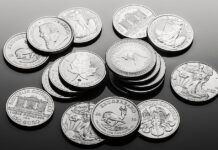In 1964, my parents bought the house I would grow up in for $20,000. Today, Zillow says the house is worth $1.2 million.
“Wow!” you might think, what a tremendous jump in prices. The house today is worth 60 times more than it 57 years ago.
Here’s the real question: Is the house worth more, or is the dollar just worth less? Let’s look at the value of the house in ounces of gold instead of dollars:
In 1964, the average price of gold was worth $35.25 an ounce, so the house was worth 566 ounces of gold. Today, with gold trading at around $1,880 an ounce, the house is worth 638 ounces of gold. Considering that my dad finished the basement and turned the attic into two bedrooms, making a two-bedroom bungalow into a four-bedroom house, that extra 72 ounces of gold is a reasonable premium.
I think we can argue that the value of the house didn’t change, but our measuring stick (the U.S. dollar) did.
Kind of makes you believe those stats we see that say the U.S. dollar has lost 98 percent of its buying power since 1913. How much more will it lose in the next few years?
The Fallacy of the CPI
The government uses the CPI, or Consumer’s Price Index, to calculate how much inflation there has been in the past month and year. Their measurement, however, isn’t straight forward. They manipulate the data to make it lower, which keeps their costs down as many programs and budgets adjust based on the CPI.
If you go to www.OfficialData.org and punch in $20,000, it will tell you that based on the CPI, that $20,000 item should now cost $172,293. That means gold should trade at $267. Both these figures are wrong. Makes you go “Hmm,” doesn’t it?
In 1985, you could buy a Ford XLT F-150 pickup with an extended cab and four-wheel drive for $11,566. Today, you are looking at $53,000 for the same trim level. Based on the official data website, $11,566 in 1985 dollars is worth only $28,705 in today’s dollars. Another example of how CPI data is incorrect.
The only good news is that if you paid in gold, the Ford F-150 today would cost you less (28.2 ounces now versus 36.5 ounces then). Based on the CPI, Ford Trucks are more expensive than they should be. Based on the price of Gold, Ford has done a remarkable job lowering the true cost of their truck while adding all sorts of new technology.
Problems with the CPI
Clearly the CPI is under-calculating the true impact of inflation. Here are just two problems:
First, it does not include the cost of buying a house. They include rent instead. The problem is that the two are not the same, and more Americans own than rent. For example, last year, rents in key cities dropped but the cost of buying a house rose.
Second, the CPU “corrects” for things like new technology. For example, if a $20,000 car introduced four years ago that now costs $25,000, you would think that is an obvious example of rising prices and inflation. But if the $25,000 model came standard with new features—like side impact air bags, a large touch screen, self-parking, and adaptive cruise control—the folks calculating the CPI may say those additions are worth $5,000 and say there has been no inflation at all.
Tell that to the person who buys the car. It’s not as if they can ask to have those items removed and pay a lower cost.
Precious Metals as an Inflation Hedge
The above examples are why gold is considered a good hedge against inflation. If you put away 30 ounces of gold in the 1960s or 1980s, or 2000s, it will buy pretty much the same thing today as it did then. The expectation is that this will continue to be true in the future. The same cannot be said for the dollar.
This is why preppers buy precious metals to preserve your wealth during a period of inflation. They cash in silver to cover your daily costs of living—such as shoes for the kids, food for the table, and gasoline for the car—but don’t cash in any gold until things have calmed down and the currency is stable.







